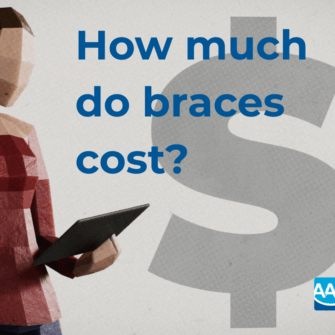What Are the Most Common Types of Bite Problems?
Your bark may be worse than your bite, but your bite is essential to your oral health. In orthodontics, “bite” refers to how upper and lower teeth come together. A bad bite called a “malocclusion” happens when teeth meet improperly or don’t meet at all.
Bite problems can develop for many reasons, and in many cases, bite problems run in families. However, childhood habits and conditions can also change the structure of your jaw, such as chronic thumb-sucking, asymmetric jaw growth from crossbites, jaw injuries, prolonged bottle or pacifier use, and cleft lip and/or palate. While each bite problem is unique, seven broad types of bite problems are common in children and adults.
1. Crossbite
A crossbite occurs when the upper teeth fit inside the lower teeth. This bite problem can be caused by a misalignment of teeth (including baby teeth) or jaws and can affect a single tooth or group of teeth. There are two primary types of crossbites:
- Posterior Crossbite: The more common of the two types, a posterior crossbite occurs when the upper back teeth fall inside the lower back teeth.

- Anterior Crossbite: This is the less common form and occurs when the upper front teeth are positioned behind the lower front teeth when the mouth is closed.

Crossbite Complications: If left untreated, crossbites can cause the jaw to shift to one side, leading to lopsided jaw growth and wearing down of tooth enamel. Crossbites can also lead to gum disease and jaw problems.
2. Underbite
An underbite is apparent when the lower jaw sits in front of the upper jaw, causing the lower front teeth to sit in front of the upper front teeth. Underbites can be inherited or develop during eruption of the front teeth in childhood. In most cases, underbites are due to differences in the growth rates of the upper and lower jaws.

Underbite Consequences: Beyond cosmetic concerns, such as a prominent lower jaw or chin, underbites can lead to dental and health issues. If not promptly addressed, they can cause difficulty in biting and chewing, speech problems, and increased wear and tear on the teeth. Underbites also increase jaw pain and discomfort because of the added stress on the jaw joints.
3. Open bite
An open bite is a malocclusion where the upper and lower teeth do not touch each other when the mouth is closed. Open bites can affect both the anterior (front) and posterior (back) teeth.
- Anterior Open Bite occurs when the back teeth are together and the upper and lower front teeth do not overlap. This can result from habits such as thumb sucking, improper tongue positioning, or mouth breathing during early dental development.
- Posterior Open Bite: When the front teeth meet, but the back teeth do not.

Open Bite Consequences: An open bite can impact oral health and function, causing swallowing problems, difficulty chewing and biting, and speech problems. In the case of an anterior open bite, a heavy bite on the back teeth without support from the front teeth may also place these teeth at higher risk for gum issues, mobility and/or fractures.
4. Deep bite
A deep bite, also known as an overbite, is a common bite problem that occurs when the upper front teeth excessively cover the bottom teeth vertically. A small amount of overlap is natural in a proper bite, but this condition arises when the overlap is more than typical. Sometimes, the upper teeth even bite into the lower gums, or the lower teeth bite into the roof of the mouth. Beyond oral fixations and childhood habits, deep bites can be caused by early loss of baby teeth, overdevelopment of supporting bone, and discrepancies in jaw growth.

Deep Bite Consequences: If left untreated, a deep bite can cause excessive wear on the teeth, leading to tooth damage, sensitivity, and, in severe cases, the need for dental restorations. This type of bite can also contribute to gum disease and jaw pain.
5. Crowding
Crowding refers to a condition in which there is insufficient space for the teeth. This lack of space causes the teeth to overlap, twist, or be pushed to the front or back. Crowding can result from oversized teeth, premature or late loss of baby teeth, poor dental habits, or inadequate space in the jaw.

Crowding Consequences: Overlapping teeth are harder to clean effectively, increasing the risk of tooth decay, cavities, and gum disease. Additionally, if not treated promptly, crowding can result in uneven wear, potentially leading to issues like enamel erosion and sensitivity.
6. Spacing
Spacing refers to the gaps or spaces between teeth. When there is too much space between teeth, a bite problem may occur. Spacing issues can result from missing teeth, undersized teeth, oversized jaws, or a combination of these conditions.

Spacing Complications: Spacing itself may not directly cause serious dental issues but can have indirect effects. Food can get stuck in open areas, increasing your risk of tooth decay and gum disease. A spacing issue can also lead to lower self-esteem, as many people are self-conscious about the appearance of gaps in their teeth.
7. Protrusion
Sometimes referred to as “buck” teeth, protrusion occurs when the front teeth extend too far forward or the lower teeth do not extend far enough forward. Genetic factors, oral habits, and teeth alignment are common causes of protrusion, and in some cases, people with protrusive front teeth may also have a deep bite.

Protrusion Consequences: The upper teeth are more prone to accidental breaking, and with protrusive front teeth, you are more likely to sustain an injury. Protrusions can also make it difficult to close the mouth and lips comfortably, leading to tooth decay, gum disease, and speech problems.
Orthodontic Treatment: The Malocclusion Solution
The unfortunate truth of bite problems in children is that they will likely not fix themselves and, if not treated by a professional, will often worsen with time. For the most effective results, bite problems are best treated while the child is still growing, and luckily, you don’t need to wait for a dentist referral to make an appointment with an orthodontist.
One goal of orthodontic treatment is to create a healthy bite. When teeth and jaws line up correctly, force is evenly distributed, allowing for proper chewing, biting, and speaking. If you suspect you or a loved one has one of these seven common bite problems, an AAO (American Association of Orthodontists) orthodontist can help.
Parents – there’s no need to wait until your child has lost all their baby teeth before you consult an orthodontist. You can consult an orthodontist when you suspect a bite problem in your child. And adults – there’s no time like the present to talk to an orthodontist about getting the smile you’ve always wanted.



